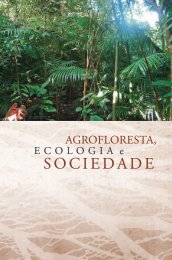Evolution of Oviductal Gestation in Amphibians
Evolution of Oviductal Gestation in Amphibians
Evolution of Oviductal Gestation in Amphibians
Create successful ePaper yourself
Turn your PDF publications into a flip-book with our unique Google optimized e-Paper software.
404 M.H. WAKE<br />
Fig. 9. Viviparous caecilians. A: Dermphis mexicanus, Fam-<br />
ily Caeciliaidae (Central America). B Qphlonectes natans, Fam-<br />
ily "yphlonectidae (northwestern South America).<br />
Dermophis mexicanus (Wake, '80a) and 2-11 <strong>in</strong><br />
Typhlonectes compressicaudus (Exbrayat, '83; Ex-<br />
brayat et al., '81, '82). In contrast to the situation<br />
<strong>in</strong> most amphbians (and reptiles), clutch size is not<br />
correlated with body size (Fig. 11) (Wake, '80b).<br />
The ovarian cycle has been described only for D.<br />
mexicanus, Gymnopis multiplicata (Wake, '68, '80b),<br />
and Typhlonectes compressicaudus (Exbrayat, '83).<br />
Three classes <strong>of</strong> ova are normally present <strong>in</strong> the<br />
ovary: small, pale pre-vitellogenic ova, vitellogenic<br />
ova, and nearly to fully yolked ova. Vitellogenesis<br />
apparently takes at least a full year, for it appears<br />
that viviparous caecilians reproduce biennially<br />
(Wake, '80a; Exbrayat et al., '81, '82). The breed<strong>in</strong>g<br />
cycle is seasonal. In Dermophis mexicanus, fertili-<br />
zation occurs <strong>in</strong> June-July and birth <strong>in</strong> May-June,<br />
after an 11-month gestation period (Wake, '80a).<br />
The gestation period is 6-7 months <strong>in</strong> Typhlo-<br />
nectes compressicaudus (Delsol et al., '81 '83; Ex-<br />
brayat et al., '81, '82, '83). Fertilization and birth<br />
may be less rigidly synchronous <strong>in</strong> Typhlonectes than<br />
<strong>in</strong> Dermophis.<br />
Follow<strong>in</strong>g ovulation <strong>in</strong> all species (oviparous or<br />
viviparous) exam<strong>in</strong>ed, corpora lutea (Fig. 12) de-<br />
velop (Wake, '68). In pregnant females the corpora<br />
lutea are large, and are ma<strong>in</strong>ta<strong>in</strong>ed throughout the<br />
gestation period (Wake, '68, '77a, '82; Exbrayat, '83).<br />
Prelim<strong>in</strong>ary data on circulat<strong>in</strong>g progesterone lev-<br />
els <strong>in</strong>dicate an elevated titer throughout pregnancy<br />
(Wake, unpubl. data). Noth<strong>in</strong>g else is known <strong>of</strong><br />
the endocr<strong>in</strong>ology <strong>of</strong> caecilians, viviparous or other-<br />
wise.<br />
Oviduct morphology <strong>of</strong> non-pregnant and preg-<br />
nant females has been exam<strong>in</strong>ed <strong>in</strong> D. mexicanus<br />
and G. multiplicata for the entire reproductive cy-<br />
cle, and for stages <strong>of</strong> pregnancy and non-pregnancy<br />
<strong>in</strong> several other species by Wake ('70, '72, '80b, '85,<br />
and unpubl. data), <strong>in</strong> Typhlonectes compressicaudus<br />
by Exbrayat et al. ('83), and <strong>in</strong> Chthonerpeton<br />
<strong>in</strong>dist<strong>in</strong>ctum by Welsch et al. ('77). In non-pregnant<br />
females the oviductal epithelium is a low monolayer.<br />
Early <strong>in</strong> pregnancy the oviduct wall hypertrophies<br />
and develops deep folds, covered by a proliferated<br />
and hyperemic epithelium. Proliferation and secre-<br />
tion beg<strong>in</strong> at 2-3 months <strong>in</strong>to the 11 month preg-<br />
nancy <strong>in</strong> D. mexicanus (Wake, '80a). The epithelial<br />
cell contents early <strong>in</strong> pregnancy are rich <strong>in</strong> free<br />
am<strong>in</strong>o acids and carbohydrates; <strong>in</strong> mid-pregnancy<br />
conjugated am<strong>in</strong>o acids and carbohydrates predom-<br />
<strong>in</strong>ate; and dur<strong>in</strong>g late pregnancy, the secretion is<br />
extremely lipid-rich (Welsch et al., '77; Wake,<br />
unpubl. data) (Fig. 13A,B,C).<br />
Development <strong>of</strong> the embryos is dependent on the<br />
yolk supply; that <strong>of</strong> fetuses on maternal nutrition.<br />
I def<strong>in</strong>e the beg<strong>in</strong>n<strong>in</strong>g <strong>of</strong> the "fetal" period as that<br />
at which yolk is fully resorbed and development is<br />
dependent on maternal nutrition. At the time yolk<br />
is resorbed and oviductal epithelial proliferation oc-<br />
curs, the fetuses m<strong>in</strong>eralize their fetal dentition and<br />
the components <strong>of</strong> the jaw articulation (Fig. 14)<br />
(Wake and Hanken, '82). The fetal dentition is char-<br />
acterized by tooth crown shape and distribution that<br />
differs markedly from that <strong>of</strong> the adult, and that<br />
changes dur<strong>in</strong>g fetal ontogeny (Fig. 15) (Wake, '76,<br />
'77a, '77b, '78b, '80b) (free-liv<strong>in</strong>g larvae have teeth<br />
<strong>of</strong> the adult form, though fewer <strong>of</strong> them). The fetal<br />
dentition is shed at birth, and replaced by the adult<br />
configuration. Wake ('77a, '80b) has conjectured that<br />
the teeth are used to stimulate secretion by mechan-<br />
ically abrad<strong>in</strong>g the oviductal epithelium; the secreted<br />
material as well as epithelial cells <strong>of</strong>ten fill the<br />
mouth and pharynx <strong>of</strong> fetuses (Wake, unpubl. data).<br />
Typhlonectid embryos and fetuses differ markedly<br />
<strong>in</strong> gill structure from those <strong>of</strong> other viviparous (and<br />
non-viviparous) species (Fig. 16ab). The gills <strong>of</strong> ter-<br />
restrial species are triramous, with long or short






